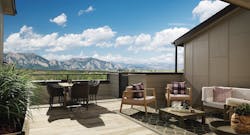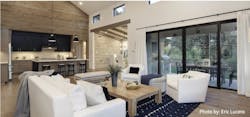What Do Home Buyers Want in 2021?
Professionals across the home building industry are adapting to the changing public health environment in reaction to the COVID-19 pandemic while continuing to build homes that fit the desires, and budgets, of their customers.
“Home” has had to take on new meaning – now needed to serve as living space, the office, the classroom, the gym and more. The 2021 edition of NAHB’s “What Home Buyers Really Want” (WHBRW) study published by the National Association of Home Builders, shows that the majority of home buyers (67%) report the pandemic has not impacted what they want in a home or a community.
On the other hand, 25% – not an insignificant share – acknowledge the health crisis has affected their housing preferences. The determining factor is whether or not there is at least one teleworker and one student participating in virtual education living in the household. When both categories are met, 43% of respondents said their housing preferences have changed overall and 35% want a larger home, specifically.
Buyers want a median of 2,022 square feet of finished space, about 8% more than the national median (1,877 square feet) they currently have.
The desire for more space within the home has also translated into a desire for more space around the home. This has led to a slight shift in preferences to areas with less density, with home buyers looking to buy farther from city centers as a result of COVID-19. Prior to the pandemic, 26% of buyers would have preferred to buy their next home in an outlying suburb. Now that share is 30% – the largest shift in preference for any location during this period. All other locations listed (e.g., close-in suburb, central city-downtown) saw either a slight decline in preference or no change at all.
Interestingly, minorities are responsible for driving the increased interest in suburban living. Among Asian American home buyers, the share in favor of a suburban location jumped nine points to 71% as a direct result of COVID-19, while also rising seven points among African American and six points among Hispanic buyers. The share only increased one point among White home buyers.
As the WHBRW study reveals, home owners want larger homes, and more space from their neighbors, with 21% stating that this preference was linked directly to the pandemic. The desire for patios, porches and other outdoor spaces is strong, according to the findings of WHBRW. The top five most-wanted outdoor features are exterior lighting, a patio, a front porch, a rear porch, and a deck – all wanted by 75% or more of home buyers.
This trend also translates to multifamily home building, according to Sanford Steinberg, a multifamily architect from Houston. “While we’re focusing more on work-from-home amenities than ever before, like meeting rooms or other A/V components, we’re also seeing a growth in demand for outdoor spaces. And not just pools, either. Beer gardens, cornhole games, fire pits, and for the first time in years – with kids staying home more than before – playgrounds,” Steinberg said.
Regarding home buyer technology preferences, WHBRW showed that a multi-zone HVAC system was among their top five most-wanted tech features in a new home.
“COVID has been a wake-up call about air quality, and it’s just the beginning to understanding what’s in our homes that make us sick,” said Jillian Pritchard-Cooke, founder of Wellness Within Your Walls, a healthy living educational organization. “Now, home owners are starting to learn about MERV ratings, and care about the thickness of their HEPA filters, but it’s just the tip of the iceberg.”
The rest of the top five most-wanted technology features deal with either energy efficiency or home security: a programmable thermostat, security cameras, video doorbell, and a wireless home security system. The desire for each of the 21 technology features listed in the survey increases directly with the buyer’s income bracket.
The top five most-wanted specialty rooms are the laundry room, a dining room, a great room, a home office, and a separate living room – all essential or desirable to over 60% of buyers. But the desire for some specialty rooms varies by generation. A good example is the exercise room, which did not make the top five list. While only 47% of buyers overall rate it essential or desirable, that share varies significantly with age. Roughly 60% of millennials and Gen X buyers consider the exercise room essential or desirable, compared to just 33% of boomers.
Home buyers on the whole clearly prefer open layouts: 85% want an open arrangement between the kitchen and the dining room, 79% between the kitchen and the family room, and 70% between the dining and the family room. “We have buyers looking for larger kitchens, or in our higher-end projects, we’re seeing buyers actually prefer a back kitchen combined with larger entertaining spaces,” said Seth Hart, a designer for DTJ Design in Boulder, Colo.
When it comes to bedrooms, the share interested in four or more bedrooms in 2020 (32%) is smaller than in 2007 (40%). The presence of children has a strong influence on this result: 47% of married couples with children want at least four bedrooms, compared to only 13% of one-person households.
A reason for the desire for fewer bedrooms may be explained by a prioritization of other rooms, though. “We have customers looking to privatize second floor loft space – which is usually space used by kids already – into more enclosed spaces for kids to do homework, play video games and relax. This helps children and adults to co-exist at home when parents are teleworking,” Hart said. While it is likely that “work from home” policies will remain in place longer than virtual schooling, the ability for all family members to go about their individual, daily lives without disrupting other family members is likely to endure. Doors of all shapes and sizes – and the private havens they create – are likely to remain popular for the foreseeable future.
Though desire for four or more bedrooms is decreasing, a plurality of buyers still prefer two bathrooms (37%). Another 21% prefer 2.5 baths, and 26% want three or more. Only 17% are looking for fewer than two baths.
For 63% of buyers, the washer and dryer belong on the first floor. While not necessarily connected to accessibility, having housing amenities on the ground floor is a key factor to making a home accessible. Looking at just accessibility, the top five most-wanted features are a full bath on the main level of the home, wider doorways (3+ feet), wider hallways (4+ feet), non-slip floor surfaces, and an entrance without steps – all essential or desirable to over 60% of buyers.
These accessibility features are especially useful in homes designed for multiple generations. When asked if they would prefer a home designed for multiple generations (the buyer plus a younger and an older generation), buyers are evenly split: 39% want it and 39% do not (with the remainder not being sure). The preference for multi-generational housing is much more pronounced among minorities, however: 53% of Hispanics, 50% of African Americans, and 46% of Asian Americans prefer it, compared to 35% of White home buyers.
Regarding energy consumption, most buyers (52%) prefer to heat their homes with electricity, while 33% prefer to do it with gas. The reverse is true for cooking: 51% prefer to cook with gas and 39% with electricity. Preferences are more evenly split for water heating: 45% prefer gas and 40% electricity.
Finally, the majority of home buyers would prefer to buy a single-family detached house (67%), and a similar share of home buyers (60%) would prefer to buy a newly built house over one that was previously owned. New single-family detached homes are the gold standard for home buyers.
COVID-19 has changed the way many home owners, and home buyers, view and use their homes. Whether they want to buy a new home or remodel their existing home, many have changed their housing preferences in an effort to keep their families comfortable, safe and healthy.
To learn more about the survey findings, visit “What Home Buyers Really Want 2021” on nahb.org.



